Recruiting
McGILL HOCKEY QUICK FACTS:
School: McGill University, Founded: 1821
Location: Montreal, Quebec, Canada
Enrollment: 29,904 (tot), 18,356 (undergrad)
Team Nickname: Redmen (M)
Team Colours: Red & White
First Hockey Game: McGill 2, Victorias 1 J-31-1877
First Intercolleg. Game (USA): McGill 14, Harvard 1, F-23-1894
First Intercolleg Game (CAN): Queen’s 6, McGill 5, F-2-1895
Home Arena / Opened: McConnell Arena (1956)
Ice Surface: 200′ x 85′
Seating Capacity: 1,000
Affiliations: Ontario University Athletics (OUA) and Canadian Interuniversity Sport (CIS)
ABOUT McCONNELL ARENA
McGill University’s McConnell Arena, situated atop University Street, behind Molson Stadium, underwent a $4 million facelift in the year 2000.
“This was a much-needed project that was long overdue,” said Robert Dubeau, director of athletics at McGill. “It was welcomed by the students, participants and spectators alike.”
The McConnell Foundation made a timely commitment to help upgrade the arena and make it a great place for the McGill community to attend and participate in winter sports activities.
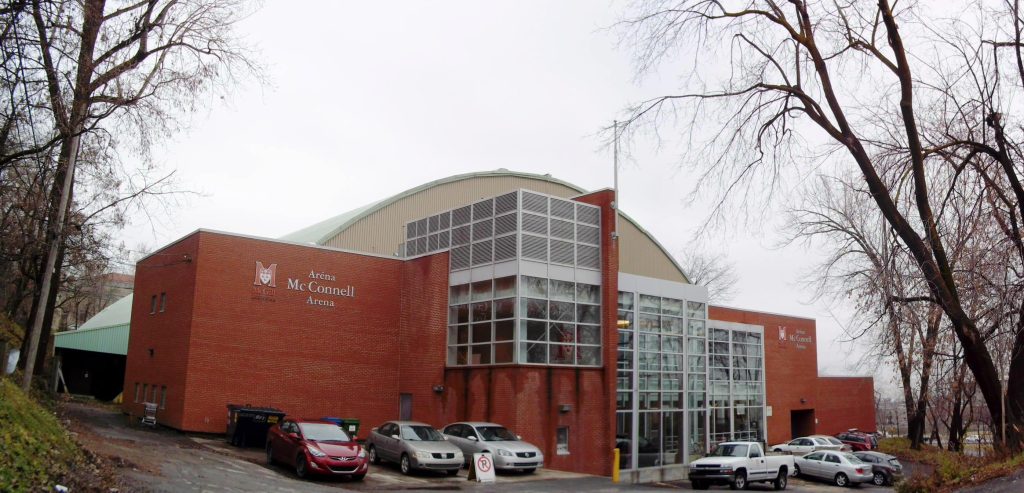
The arena was originally opened in 1956, some 79 years after McGill students formed the first organized hockey club in 1877. Its initial construction was made possible through a generous gift from J.W. McConnell, then a senior governor of the university. For many years prior to the opening of McConnell Winter Arena, the McGill Redmen played their home games at the Montreal Forum.
Before playing at the Forum, McGill used a variety of local arenas for its home games, including the old Mt. Royal Arena, which was christened on January 10, 1920 with a McGill hockey game.
Other arenas used by McGill prior to 1920 included the old Victoria Skating Rink (where the first game of organized hockey was played in 1875), the Crystal Palace Skating Rink and the outdoor rink on the University’s lower campus.
With the most recent turn of the century, demands for the use of McConnell Arena have grown with the changing times. The Montreal Canadiens have frequently requested use of the McGill arena as a practice facility. Aside from the ice-time allotted to the McGill Redmen and Martlets hockey teams, more space was needed to accommodate some 70 intramural teams, in addition to numerous recreational and physical education activities.
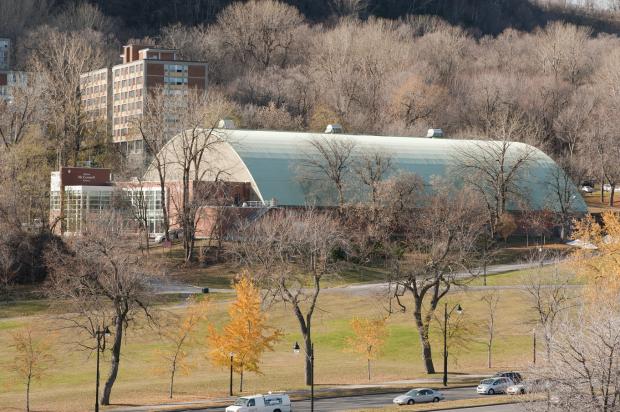
“I was pleased that the project was scheduled to coincide with the 125th anniversary of our men’s hockey team in the 2000-01 season,”said Martin Raymond, head coach of the Redmen. “It will accelerate our recruiting efforts and definitely benefit our hockey program in search of that elusive championship.”
Peter Smith, head coach of the McGill women’s team, was equally pleased about the arena upgrade. “These renovations provide our student-athletes with a top-notch venue in which to train and compete,” he said.
The renovations were designed to be completed in two stages in order to avoid disruption of the busy winter schedule of intercollegiate contests, intramural activities and instructional courses. In the first phase of the arena project, conceived by Montreal architect Brian Burrows, the front of the building was re-designed and now includes a new entrance, lobby, concession stand, management and ticket offices, a classroom and a 2,200 square-foot alumni lounge, which overlooks the ice surface.
The second phase, completed in the fall semester, included new team dressing rooms for the Redmen and Martlets, increasing the number of locker rooms in the arena to seven. Also, two offices were added for use by McGill’s head coaches, in addition to a coaches changing room, a physical therapy mini-clinic and a weight-training room. The interior of the arena was redecorated, featuring new seating which extends down to the glass at ice level. The team benches and penalty box were re-designed, a new clock and sound system was installed and the ice-making plant was enhanced.
The official re-opening of McConnell Arena was marked by a souvenir square puck — a replica of the one used by the McGill hockey team in 1877 — which was handed out to all fans in attendance.
The most recent improvement, completed in December, 2002, was the addition of photos and banners — from McGill’s historic hockey past — in the lobby and alumni lounge.
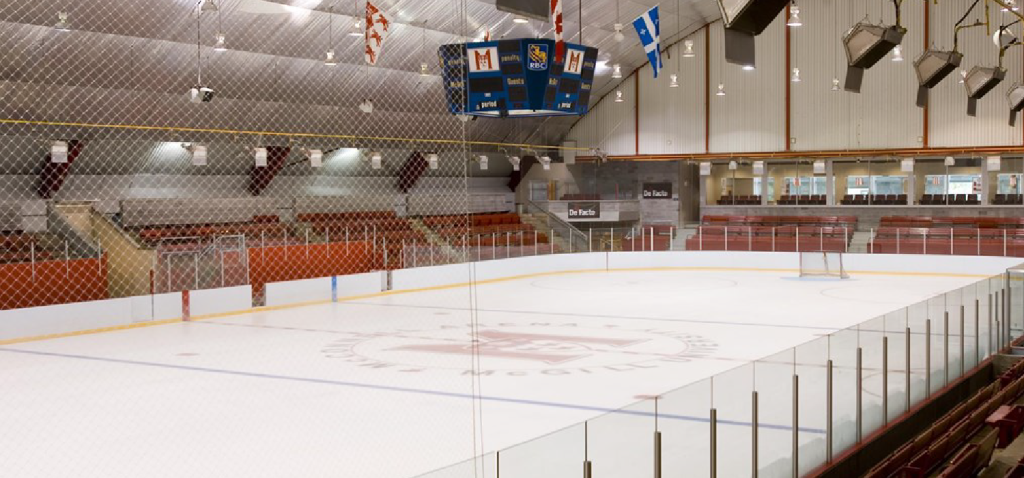
McGill’s 26 Hockey Championships
CIS OUA EASTERN CONFERENCE CHAMPIONSHIP:
(2 titles):
- 2005-06
- 2008-09
Canadian Inter-collegiate Hockey Union
Queen’s Cup (14 titles):
- 1902-03
- 1904-05
- 1911-12
- 1929-30
- 1930-31
- 1932-33
- 1933-34
- 1934-35
- 1935-36
- 1936-37
- 1937-38
- 1938-39
- 1945-46
- 2007-08
- 2009-10
International Intercollegiate Ice Hockey League
Alexis Thompson Trophy (3 titles):
- 1936-37
- 1937-38
- 1938-39
Quebec Senior Hockey League (2 titles):
- 1930-31
- 1933-34
Quebec Amateur Hockey Association
(2 titles):
- 1920-21
- 1933-34
Montreal City Hockey League
Dandurand Trophy (2 titles):
- 1917-18
- 1920-21
Montreal Winter Carnival (hockey’s 1st ever championship)
Birks Carnival Cup (1 title):
- 1883
About McGill University
McGill University in Montreal received its Royal Charter in 1821 and was formally opened in 1829, when instruction in medicine finally got underway. As one of North America’s older universities, it has seen much growth and change since those early days. In response to the realities of life in what was then known as Lower Canada, McGill stressed practical fields of education such as medicine, law, science and engineering, while retaining the liberal arts inherited from the British tradition.
The result has been the development over the years of a unique Canadian institution. Today, McGill enjoys an international reputation in many fields. It has maintained a tradition of scholarship and research. The 80-acre property on the lower slopes of Mount Royal is the home-away-from-home for some 31,100 students and 7,000 staff members.
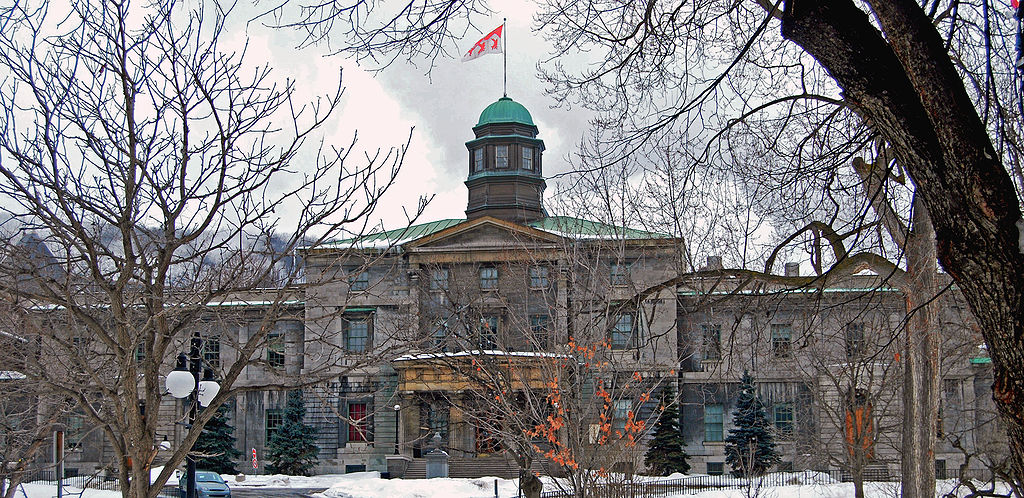
McGill’s sprawling campus, with its historical buildings, modern laboratories, recreational facilities and green space, serves as the ideal university setting. In addition to the main downtown campus is the Macdonald campus, located 25 miles west of the city’s core in suburban Ste-Anne-de-Bellevue. This west-island campus houses the University’s faculty of Agriculture and Environmental Sciences, the School of Dietetics and Human Nutrition, the Institute of Parasitology, and the Brace Research Institute specializing in alternative energy sources and desalination.
There are also other distant research facilities, however, the downtown campus has always been the hub of activity and administration. Today, McGill students can choose to enroll in one of 21 faculties and professional schools and take part in wide-ranging extracurricular activities. There is an increasing number of francophones in the ranks of students (25%) and staff, and as more cooperative ventures with other universities in the province unfold, McGill has become more and more integrated into the Quebec milieu; but it also maintains a strong sense of its past and takes great pride in its international ties.
Two centuries ago, it would have been hard to imagine that a university of international reputation would find itself situated on a tract of land which was then a farm on the outskirts of a rough-and-tumble colonial town. But James McGill, a Scottish settler who had amassed a fortune in the fur trade, realized the value of education. When he died in 1813, McGill bequeathed his Burnside estate of 46 acres and a sum of £10,000 to the Royal Institution for the Advancement of Learning. He had wished for his donation to be directed towards the establishment of a university but litigation over the endowment and indecision on the part of the administrators nearly shattered McGill’s dream.
It was only after the appointment of Sir William Dawson as principal in 1855, that the university finally achieved a firm financial and academic footing. Dawson, who later gained worldwide recognition as a natural scientist, was undaunted by the magnitude of the challenge he faced. He quickly turned his energies towards developing the sciences and professions which remain McGill’s strengths, and oversaw the construction of numerous buildings which are still in use. During his 38-year tenure, the university earned a place among the great seats of learning in North America.
McGill is also among the most prominent academic institutions in the world with regard to the development of men’s and women’s athletics. At the varsity level, McGill teams are steeped in tradition and the origins of sport. The football team, which in 1987 became the first Quebec university team to win the national football championship, was founded in 1863 and had its “intercollegiate baptism” on May 13, 1874 when it travelled to Cambridge and played Harvard in the world’s first “North American-style” intercollegiate football game.
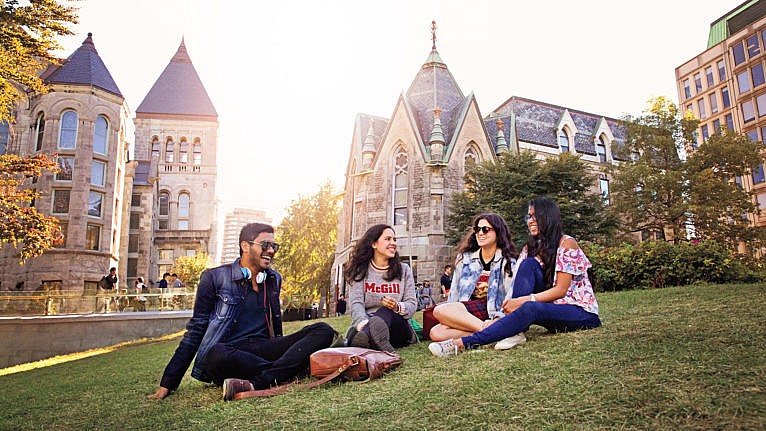
In 1873 James Creighton (who would later become a McGill law student), was said to have devised some informal rules for a new game which later became known as ice hockey.
On March 3, 1875, a number of McGill students played in what is recognized as the first indoor game of hockey at the Victoria Skating Rink. Two years later, McGill students formed the first organized hockey team and defeated the Victoria Skating Club 1-0 in their first official game, played on January 31, 1877.
Basketball was founded in December of 1891 by James Naismith, a native of Almonte, Ont., who had played rugby-football at McGill and graduated with a Doctor of Divinity degree in 1889. He went on to become McGill’s first director of athletics in 1890. A year later, Naismith moved on to a new position at Springfield College in Springfield, Mass., where in 1891, he devised the rules to the game of basketball.
The sport was first played in Montreal’s YMCA in 1892 and subsequently began at McGill with inter-faculty games in 1894. A decade later, McGill met and defeated Queen’s in the first-ever Canadian intercollegiate basketball game in Kingston, Ont., on February 6, 1904.
Currently, with 43 different intercollegiate teams, McGill ranks fourth among Canadian universities in total number of sports clubs. In addition, there are over 700 intramural teams plus an extensive Active Living program that encompasses a wide variety (55 in all) of non-credit fitness and recreation courses.
NOTABLE McGILL PEOPLE:
Nobel prize winners:
Val Fitch (physics, 1980),
David Hubel (medicine, 1981),
Rudolph Marcus (chemistry, 1992),
Ernest Rutherford (chemistry,1908),
Andrew Victor Schally (medicine, 1977) and
Frederick Soddy (chemistry, 1921).
Notable graduates:
Mike Babcock, Detroit Red Wings (head coach, 2005-present), Anaheim Mighty Ducks (head coach, 2002-2005);
Russ Blinco, Montreal Maroons centre who won Calder Trophy as NHL Rookie-of-the-Year in 1935;
George Burnett, NHL coach (head coach in Edmonton and asst. coach in Anaheim);
Doug Carpenter, ex-NHL coach, New Jersey;
Mathieu Darche, NHL hockey player (Columbus);
Ken Dryden, president, Toronto Maple Leafs; also a Vezina trophy winner with the Montreal Canadiens, who earned his law degree while playing in the NHL;
Jack Gelineau, Boston Bruins goalie who won the Calder Trophy as NHL Rookie-of-the-Year in 1950;
Dick Irvin, author, broadcaster, Hockey Night in Canada;
Bruce Firestone, ex-owner of the NHL’s Ottawa Senators and the CFL’s Ottawa Rough Riders;
Bryan Murray, NHL general manager (Florida, Anaheim);
Brian O’Neill, NHL Exec. VP;
Frank & Lester Patrick, hockey pioneers;
Samir Chahine, CFL football player (Toronto, Edmonton);
Randy Chevrier, NFL & CFL football player (Dallas, Cincinnati, Edmonton);
Ryan Coughlin, CFL football player (Montreal);
J.P.Darche, NFL football player (Seattle);
Michael Soles, CFL football player (Edmonton, Montreal);
Val St. Germain, CFL football player (Edmonton, Ottawa);
Larry Smith, CFL commissioner, president, Montreal Alouettes, publisher Montreal Gazette;
Dr. James Naismith, inventor of basketball;
Kevin O’Neill, asst. coach, NBA’s NY Knicks;
Gord Cleland, pro player agent,
Don Meehan, pro player agent;
Richard Pound, Vice-President, International Olympic Committee;
Howard Stupp, director of legal affairs, International Olympic Committee;
William Shatner, actor, Star Trek’s Captain Kirk;
Leonard Cohen, poet-songwriter;
Conrad Black, historian, president of Angus Corporation;
Thomas Chang, professor, developer of the first artificial cell;
John E.Cleghorn, chairman & CEO, Royal Bank of Canada;
Carrie Derick, first woman professor in Canada;
Charles Drew, surgeon and pioneer in blood plasma research;
Arthur Erickson, architect;
Donald Hebb, pioneer in behavioural psychology;
John Humphrey, author of the United Nations Declaration of Human Rights;
Frances Oldham Kelsey, honoured for her fight against the use of thalidomide in the U.S.;
Charles Krauthamer, weekly columnist for The Washington Post; senior editor of The New Republic; winner of the 1987 Pulitizer prize for commentary;
Sir Wilfrid Laurier, lawyer, former Prime Minister of Canada;
Ronald Melzack, professor, pioneer of modern research on pain;
Elizabeth Monk, one of the first two women admitted to the Quebec Bar;
Pierre Péladeau, founder, president of Quebecor Inc., publisher of Le Journal de Montreal;
Simon Reisman, Canada’s free trade ambassador;
Charles Scriver, geneticist & pediatrician in genetic diseases;
Raymond Yong, world authority on permafrost engineering & industrial waste disposal.
